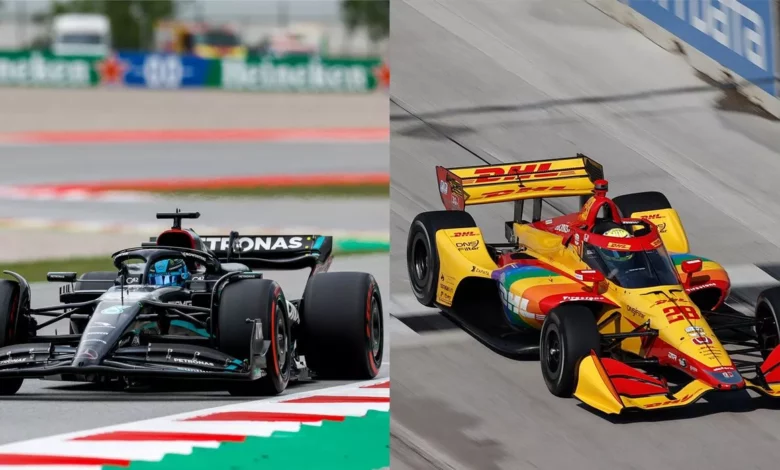F1 vs IndyCar: How the open-wheel single-seater series compare
How two of the most popular racing categories in the world stack up against one another

Formula 1 and IndyCar racing look very similar from the outside. Drivers race in single-seat, open-wheel cars around road and street courses of similar lengths. But there are some key differences when comparing F1 vs IndyCar in almost every aspect of the racing. Here’s how the two series stack up:
F1 car vs Indy car: Engine and top speed
Both series use V6 internal combustion engines but with different sizes and configurations. Formula 1 cars use 1.6-liter turbocharged hybrid V6 engines that use energy from exhaust heat and braking to charge the hybrid battery. Though it’s a small displacement, an F1 engine packs a lot of power. Formula 1 teams don’t usually provide specifics on power output, but the four engine manufacturers, Ferrari, Mercedes, Renault, and Red Bull Powertrains (formerly Honda) are all above 1000 horsepower. The cars typically hit nearly 200 mph on straights during most tracks but can get to nearly 225 mph on the fastest tracks like Monza and Mexico City.
IndyCar engines are 2.2-liter twin-turbocharged V6 powertrains for 2023. This season is the final year before the engine formula will change to resemble Formula 1’s hybrid V6 configuration. Though the engine is slightly larger than in Formula 1, IndyCar powertrains make less power. It’s roughly 550-750 horsepower, depending on the boost level used in the turbos. But because the IndyCar Series races on ovals with very small wings for those events, the cars end up reaching speeds of 240 mph. There are two engine manufacturers for the series: Chevrolet and Honda.
Both series have a way of increasing passing during the races. Formula 1 uses the drag reduction system (DRS) that opens a flap in the rear wing when a driver is within one second of the car in front of them. This reduction in drag means drivers can temporarily boost straight-line speed, often 5-10 mph. IndyCar uses push-to-pass, which temporarily gives a driver 50 more horsepower. The push-to-pass system is limited to 200 seconds a race and is the same for all drivers.
Races at the Circuit of the Americas in Austin, Texas, provides an example of the difference in lap time. In 2019, Valtteri Bottas qualified on pole for the Formula 1 race at 1:32.029. By contrast, IndyCar’s best time on the track is 1:46.018. Formula 1 cars have much more downforce and go faster through corners.
F1 car vs IndyCar: Car configuration
Each Formula 1 car is created by a group of designers on each team. These designers build from the ground up to cover the chassis, suspension, and aerodynamics. This means teams can reach a common convergence on ideas but often have specific, unique design attributes to their cars. Because there are four engine suppliers for 10 teams, some buy multiple components from other teams. In 2023, Aston Martin uses Mercedes engines and because of that, they also buy Mercedes’ transmission and rear suspension.
Indy cars all have a spec chassis built by Dallara, and the same aerodynamic kits are provided to each team. This reduces costs and keeps the racing closer as teams can’t put millions of dollars into finding an advantage.
F1 vs IndyCar: Race schedule and duration
Formula 1 is a world championship with 22 races across five continents (Europe, North America, South America, Asia, and Australia) in 2023. IndyCar is more regional, with 16 races in the U.S. and one in Canada.
Formula 1 races end after 189.5 miles but can be limited to two hours in case of bad weather or safety car periods. In IndyCar, it depends on the race. Oval races have no time limit and run to distance despite any stoppages that might occur, but there is a two-hour time limit for road and street courses. IndyCar organizers can change the time limit if need be for road and street track events.
Both series use one single tire supplier. Formula 1 works exclusively with Pirelli, and IndyCar only uses Firestone tires. IndyCar races include refueling during the race, while Formula 1 has banned refueling since 2010. Because of this and smaller crews, pit stops are longer in IndyCar (7-8 seconds) than in Formula 1 (2-3 seconds).
The series’ points systems are one of the biggest differences. In Formula 1, the top 10 finishers receive championship points in a 25-18-15-12-10-8-6-4-2-1 format. One championship point is awarded to the driver with the fastest lap of a race, but only if they finish in the top 10. In IndyCar, every finishing driver receives some championship points, broken down like this:
- 1st place – 50
- 2nd place – 40
- 3rd place – 35
- 4th place – 32
- 5th place – 30
- 6th place – 28
- 7th place – 26
- 8th place – 24
- 9th place – 22
- 10th place – 20
- 11th place – 19
- 12th place – 18
- 13th place – 17
- 14th place – 16
- 15th place – 15
- 16th place – 14
- 17th place – 13
- 18th place – 12
- 19th place – 11
- 20th place – 10
- 21st place – 9
- 22nd place – 8
- 23rd place – 7
- 24th place – 6
- 25th and below – 5
Drivers receive an extra point for leading at least one lap of the race. The driver with the most laps led gets two points and the polesitter gets one point as well.
Qualifying format
F1’s qualifying format breaks down into three sections: Q1 (18 minutes), Q2 (15 minutes), and Q3 (12 minutes). The five slowest cars in Q1 are eliminated from the next round and take grid positions 16-20. The five slowest in Q2 are eliminated from the next round and take positions 11-15 for the start of the race. Ten remaining drivers determine starting positions 1-10 during Q3.
IndyCar’s qualifying format changes based on track layout. Road and street courses have all cars divided into Group 1 and Group 2. Each driver gets 10 minutes to set the fastest time they can. After the 10 minutes is up, the six fastest drivers from each group advance to the next round. The rest fill in positions from the 13th to the bottom of the order. The 12 remaining drivers go for another 10 minutes to set the fastest time they can. Those who do not advance take positions 7-12 on the starting grid. The six fastest drivers, commonly called the Firestone Fast Six, make it to the final 10-minute round to determine who takes pole through sixth for the race.
Oval tracks have a different qualifying format. Cars are randomly drawn, and drivers have two laps to warm up before two timed qualifying laps. More warmup laps are allowed at IndyCar organizers’ discretion. The average speed and time are combined from the two laps to determine the fastest time and the order.
Qualifying for the Indy 500 is slightly different, with four timed laps instead of two and the fastest nine drivers competing for the top nine positions. The five slowest drivers compete for the final three spots.
F1 vs IndyCar: Viewership
IndyCar is a more regional sport than Formula 1, but the two series have similar viewership. The biggest race of the year, the Indy 500, garnered around five million viewers in 2023. Over the 2022 season, IndyCar averaged about 1.3 million viewers per race in the U.S., a small bump over the prior years.
Formula 1’s latest estimates for the 2022 season put an average of 1.2 million viewers per race, a small fraction of the 70 million average viewers worldwide.
For motorsports betting news, odds analysis, and more, visit Point Spreads Sports Magazine.
Follow us on Twitter








